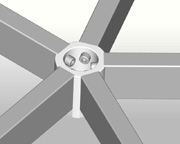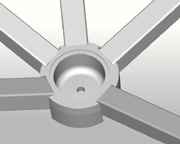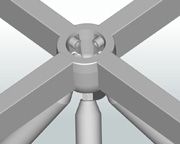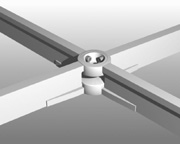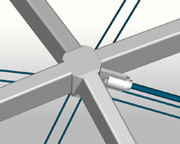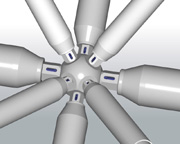Spaceframe System
1. KK-SYSTEM
– Load applied to the nodes
– Single or Multi-layer
– Each node has up to 18 threaded holes as pin jointed connections
– Gives greatest freedom in design
System Description
The MERO KK-System, the 1st prefabricated Spaceframe System, has a high degree of versatility in its applications. Spaceframes are filigree systems out of nodes and members. Loads are applied via the nodes, the members distributes the compression and stress forces.
The members are round hollow sections because they have the best resistance against buckling. Diameters range from 30 to 355mm with different wall thickness. The length differs from 1.5m to 5.0m but is not fixed. The nodes are balls, to give a free selection for the connection holes. The standard ball nodes have diameters from 49.5mm to 350mm. To connect several members to a relatively small node, the members will have to be conical at the ends. The members are connected via high tensile bolts. The bolt has a dowel pin and is screwed into the node via a sleeve. Compression is transmitted via the sleeve, stresses via the bolt. Single and multi-layer Spaceframes can be designed.
Design Application
Loads from cladding or suspended loads should be applied via the nodes. Membranes are directly fixed to the nodes while roofing sheets are fixed to the purlins which are attached to the nodes via a purlin stool.
Material Choices
This System can be of steel, aluminium or stainless steel.
Additional Pointers
The KK-System can be combined within on project with NK-System, BK-System or even traditional steel sections.
Project Reference:
1.1. Woodlands Checkpoint – Border Station
1.2. King’s Centre Super Structure
1.3. Rendezvous Hotel
1.4. Tuas Checkpoint – Border Station
2. NK-System
– Double-layer structure
– Pin-jointed connection to the nodes
– Lower chord as ball node system
– Plane or vurved surfaces
– Average to wide-span structure
System Description
The MERO NK-System is derived from the double layer KK-System, with the advantage that cladding of glazing can be directly fixed on the top chord without additional purlins. Thus, a higher transparency of glazed structures is achieved.
Standard bowls have diameters from 160 to 200mm. The members of the top grid are rectangular hollow profiles, approximately 1.5 to 4.0m long. The members are pin jointed to the nodes and the screws are not visible. Members and nodes are flushed and restrained torsionally. The nodes and the members of the bottom grid such as the diagonals correspond to the KK-System.
Design Application
Loads from cladding/glazing are applied directly to the RHS profiles of the top chord. If small panes have to be considered, additional rafters can be integrated in the level of the top grid. Loads can be applied to the ball nodes of the bottom chord.
If the double layer NK-System is combined with the single layer ZK-System, the NK bowl nodes can be designed with the bend resistant connection of two screws per member.
Project Reference:
2.1. Singapore Arts Centre (Theatres on the Bay)
3. BK-System
– Single or Multi-layer structure
– Single bolted connections
– Sharp changes in inclination of roof i.e. shed
Project Reference:
3.1. Bugis Junction
4. ZK-System
– Single-layer structure in triangular and/or trapezoidal surface geometry
– Bend resistant connection
– It is used specifically for curved surfaces of average span structures
– Small to middle spans
– Cladding elements fixed directly on members
System Description
The cylinder node provides a bend resistant connection. Thus, plane and curved single layer constructions can be executed with triangular or quadrangular girds. The quadrangular grid is very economical with respect to cost.
RHS profiles are connected to the cylinder node by two or four bolts per member. The connection is a flush fit and torsion proof. The standard nodes have a diameter of 200mm, the member sections are from 100x60mm to 160x80mm. The members, with lengths of 1.0m to 4.0m, are screwed via bolt insertion holes.
Design Application
Loads are applied directly to the RHS profiles. The connection resists bending forces. If small panes have to be considered, additional rafters can be integrated.
Additional Pointers
For wide spanned structures, the single layer ZK-System can be combined with the double layer NK-System.
5. TK-SYSTEM
– Single-layer system in triangular surface geometry
– Pin-jointed connection to the nodes
– Curved surfaces of small to average span structures
System Description
The disc node is the most specialized connector. It is only applicable for curved structures with triangular grids.
RHS profiles are bolted with discs nodes. The connection is a flush fitting and torsion proof. The standard nodes have a diameter of 200mm with member section ranging from 70x70mm to 90x90mm. The members with lengths of 1.5m to 3.0m are bolted and concealed.
Design Application
Loads are applied to the members. Compression, stress and shearing forces are transmitted to the nodes. If small panels have to be considered, additional rafters can be integrated. Each perimeter node has to be supported.
Additional Pointers
For wide spanning structures, the single layer TK-System can be combined with the double layer NK-System.
6. MAINLAND SYSTEM
Single layer structures with high, slender sections
Bending-stiff, pin-jointed connections
Plan and curved free-formed grid shells with targe warping
